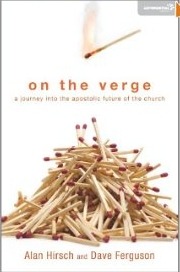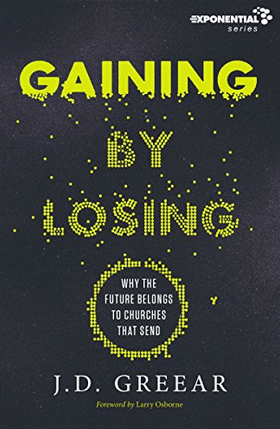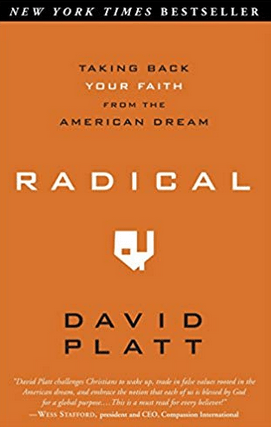on the verge: a journey into the apostolic future of the church
by Alan Hirsch and Dave Ferguson
Alan Hirsch is a great author, made better by teaming with Dave Ferguson. On the Verge is a treasure trove of information and ideas about the missional-incarnational apostolic church movement. I believe it should be in the library of every pastor and church leader and referred to repeatedly. In this article I will mention some of the great ideas I personally gleaned from it.
One of the key points in the book agrees with what Neil Cole emphasized in his important work, Organic Church: smaller is better for reproducing churches. Although Dave Ferguson is a mega-church, multi-site pastor, he is working to go small, too.
The authors advise their readers to think movementally, structure as a network, and spread like a virus.
Smaller is better for a movement for a number of reasons. The authors have a couple of graphics to show this. One compares different varieties of church structure on a continuum moving from institutional to what they call “movemental.” The most institutional form of church is the sacramental “high church” such as the Catholic or Episcopal Church. Moving toward “movemental,” the next kind of church is what they call the traditional church, which would include most mainline Protestant churches. Next we have contemporary churches, which include mega and multi-site churches. The next are what the author calls micro-missional. This is the kind of church LifeNet is here in Alamance County, NC. The final step in the progression are “apostolic movement” churches which multiply rapidly. Hopefully this is in LifeNet’s future. It is hopeful to me that we seem to be positioning ourselves well to be a part of what some believe is a new kind of reformation of the church, moving it away from what some call the building-centered “Constantinian” model to the networked small group model seen in the New Testament and more recently in China.
The move away from the Constantinian model is a move away from the church as an institution toward a paradigm that is a “more fluid, adaptive, reproducible, people movement.” (p.32)
The authors are not “against” any form of church, but they encourage at least a hybrid approach to mission – not so much either/or, but both/and. This is the basic theme of Hugh Halter’s book, AND: The Gathered and Scattered Church, which I have also reviewed. Alan Hirsch also penned an important book entitled The Forgotten Ways. Some of that book’s content is reiterated in on the verge, mainly in a recapitulation of his concept of “Apostolic Genius” and “mDNA.” The basic idea associated with Apostolic Genius is that every church – in fact, every believer – has encoded in him or her all that is necessary to launch a gospel people movement, just as a single acorn has the potential to produce an entire forest over time. This idea seems to be confirmed in the house church explosion in China where every believer is taught to be a church planter. They teach their disciples that “conversion is commission” and “baptism is ordination.” (p.44)
Missional DNA (mDNA) is subdivided into six elements, which, if present in a group, according to Hirsch, will produce a people movement. They are Jesus is Lord, disciple-making, apostolic environment, missional-incarnational impulse, organic systems, and communitas. If you want a more detailed analysis of each, please read either on the verge or The Forgotten Ways.
Another necessary ingredient of a genuine people movement is a “chaordic” approach to structure and organization. People movements move and grow so quickly that it is impossible to control them. Leaders must rely on organic systems of networking which depend on holding common beliefs, loyalties, purpose, principles, and values. This is in contrast to trying to maintain a controlled top-down managed environment.
Quoting Dee Hock, the author of The Birth of the Chaordic Age, the authors say that churches that embrace a chaordic model must have “enough order at the center to give common identity and purpose, [and] enough chaos to give permission to creativity and innovation.” (p.46)
Movemental churches will experience a continual cycle of “seeing” (imagination), “getting it” (shift), and “doing” (innovation). The authors cover these steps in detail later in the book in four parts: Imagine, Shift, Innovate, and Move.
Imagine
In the section on imagination, the authors write:
…reframing the central paradigm of the church is one of the keys to change and much-needed innovation. A paradigm shift is a change to a new game, a new set of rules. And this in turn means we must reactivate our underutilized imaginations. Verge church thinking therefore is first and foremost an exercise in a distinctively apostolic imagination…(p.61)
…the godly imagination, because it is grounded in the gospel and inspired by the Holy Spirit, is hopeful, creative, and transformative. Applying this, we would then say that the fundamental job of apostolic imagination is to produce out of the church we now experience a vision of the church Jesus wants us to experience. (p.68)
Mission inspires innovation, deeper cultural engagement, and calls for more integrity in our witness. And because mission is tied to the very being of God and to the work of Jesus, it offers the imagination a profoundly rich resource in engaging culture, incarnating the gospel, sharing faith, and forming faith communities.
Reengaging missional ways of doing church is a direct route to renewal of our theology and ecclesial imaginations. (p.69)
If you do not get anything else from this book, please let the last quote sink in. LifeNet has been putting this into practice for several years now as a church, and it has fundamentally changed how we view and practice “church.” We have moved from seeing ourselves primarily as a group that meets on Sunday in a building to being a network of neighborhood-based missional communities exploring ways to connect as friends. We are ministers of reconciliation with those who live, work, and play around us. For us this led to the rather radical step of letting our building go in order to focus on increasing our community presence, while still meeting together as a network at least monthly. As the authors have said, unless we put action to our imagination, we will never have innovation.
What we are now is not likely to be what we will become, at least on the structural and organizational side of things. The book gives a handy acronym for the ongoing process of innovation – IDEA. Imagine and investigate, design, experiment, and then make adjustments as needed.
Unless we break free from the “psychic prisons” of our old paradigms, we may be headed for a European experience, where only two percent of the population is involved in the church. “We need to [be willing to] give up every preconceived notion, follow humbly wherever the Spirit will lead us, and laugh at our own nakedness.” (p.88)
We need to become risk takers and get out of the boat as did Peter. We must allow the Spirit to break down restricting paradigmatic walls (strongholds of the mind, so to speak).
For example, did you know that 65% of the leadership in the Chinese underground church are women? (This is a genuine chaordic people movement which has seen the church grow from two million to around 130 million over the last sixty years during a time of intense persecution.) The number of women pastors gets even higher in church movements in India and elsewhere. This is not surprising when we consider that women played significant roles in early Christianity. Over 40,000 of Yoido Full Gospel Church’s 50,000 cell churches are pastored by women. Either God is allowing and blessing a paradigmatic error that allows women to be pastors, or these ground breaking Christian movements are on to something. (p.95)
Shift
The next section is about the shift that needs to take place if we are going to become a movement. One of the most interesting ideas I got from this part of the book is that we need to help the people in the church adopt missional practices so they can act their way to obedience and understanding.
Because Jesus designed the church to be a disciple-making system, it should be expected that everyone in the movement has an active role to play. No one who claims faith in Jesus is exempt from the call to follow him. It should be an explicit expectation that when someone comes to faith, they immediately get involved in the church’s practices – even before they might fully understand why they are important and how they express the ethos of the movement…Don’t reward mere spectatorship and attendance. Require active involvement in what it means to become like Jesus. Only in this way can we expect to create Jesus followers out of a church full of Jesus admirers. (pp.174-5)
So developing core practices must be seen as the “business end” of the Verge church process…The Hebrew worldview was a life-oriented one and was not primarily concerned with concepts and ideas in themselves.We simply don’t believe we can continue to try to think our way into a new way of acting: rather we need to act our way into a new way of thinking. (pp. 176-7)
The authors suggest developing an acronym that helps people remember the church’s values and practices – VISA: Visit, Invite, Serve, and Ask. Encourage our folks to Visit their neighbors to show interest, friendship, and to offer to pray for them. Secondly, ask our people to routinely open their homes to show hospitality, to Invite their friends and neighbors over for a meal, games, dessert, etc. These times around a meal can provide some wonderful opportunities to talk about deeper concerns, including the Gospel. It shows people that we care. The “S” stands for Serve. People can look for ways to practically serve in the community in a way that says we love and care about people. Lastly, we want to develop a practice of Asking God to work in the lives of those around us and to give us opportunities to be lovingly bold in sharing our faith.
Innovate
The next section is called “Innovate.” Chapter 7 is entitled “Innovate or Die.” I remember when Buddy Walker once visited our church a few years ago when we were first learning to be missional. He told me that he believed unless we changed how we do church, we would cease to exist. He asked me a very important question: “If you had the choice between pastoring a megachurch or a network of “house” churches, which would you take?” I knew immediately that I would take the latter. It has taken us a while to get there, but we are now officially a network of missional-incarnational communities that meet in homes and other venues, and also as a network. Buddy had the word of the Lord for us, but it has been a slow process to fully embrace innovation. It is not easy to let go of what is known and familiar to launch out into the deep in pursuit of God’s mission. It sounds Abrahamic, doesn’t it – going to somewhere as yet unknown as led by God?
The Japanese character for “crisis” is a combination of the characters for “danger” and “opportunity” (or promise); crisis is therefore not an end of opportunity but in reality only its beginning; the point where danger and opportunity meet; where the future is in the balance and where events can go either way. (David Bosch, Missiologist p.203)
The authors describe some of the characteristics of what they call a Verge leader. He or she leads from the front, modeling the desired behaviors. Verge leaders have an attitude of curiosity instead of absolute certainty.
“The one who can lead with the crystal-clear vision of a general and still maintain the curiosity of a child is a special leader and will foster innovation in the people around him or her. (p.212)
A Verge leader leads with a Yes and asks how later, or as Peter Block puts it, “The answer to how is yes.” If we are going to innovate, we must create a culture of giving permission to release the creativity and innovation built into the people of God.
Cynicism masquerades as wisdom, but it is the farthest thing from it. Because cynics don’t learn anything. Because cynicism is a self-imposed blindness, a rejection of the world because we are afraid it will hurt us or disappoint us. Cynics always say no, but saying yes begins things. Saying yes is how things grow. (p.218)
If we engage in a blue ocean strategy – and I believe we have to if we are to engage the 60 percent of the population that is increasingly alienated from our prevailing expressions of church – then we simply have to innovate…What got us here is unlikely to lead us there. (p.222)
To successfully make this paradigmatic shift to become a Verge church, it requires a leadership willing to kick people out of their steepled boxes. It requires leadership that pushes others beyond discussion about mission to actually doing mission. (p.228)
Move
Chapter 9 introduces the section called “Move,” which is about putting everything we have learned into action. It’s about transforming the church into a “viral, highly transformative, gospel movement. It’s a reproducing church whose sole focus is the mission of Jesus filled with people who are engaged in mission in every sphere of life. (p.259) The authors put forth eight rules for becoming a movement. If you want to read about all eight, you will need to get the book. I will mention a couple that were especially meaningful to me.
The Small Rules
In Church 3.0, Neil Cole champions the power of small things. Why is small so big? Small does not cost a lot. Small is easy to reproduce. Small is more easily changed and exchanged. Small is mobile. Small is harder to stop. Small is intimate. Small is simple. Small infiltrates easier. Small is something people think they can do. Big doesn’t do any of these things.
We can change the world more quickly by becoming much smaller. (p.287)
The Network Rules
“If the Apostolic Genius expresses itself in a movement ethos, it forms itself around a network structure…when you couple Apostolic Genius with networked structures, you have in front of you the potential for world redemption.” (pp.290-1)
Closing Thoughts
In some closing thoughts, Hirsch writes:
I have little doubt that the biggest blockage to people-movement is the professionalization of the ministry of Jesus Christ. It has two effects: (1) it limits ministry to an elite group which inevitably replaces the priesthood of all believers/apprentices, and (2) it lets the people of God…off the hook of their God-given calling to be apprentices who are agents of the King in every sphere and domain. (p.292-3)
He went on to write that the extraordinary and explosive growth experienced by the Methodist Church in the early days of the United States was due in large part by a
“mobilization of ordinary people – white and black, young and old, men and women – and the removal of artificial barriers to their engagement in significant leadership as class leaders, local workers, and itinerant preachers.” (p.293)
New understandings of doing ministry must be created with each new generation for the church’s mission to move forward…The day of the professional minister is over. The day of the missionary pastor has come. (Kennon Callahan, Church Consultant, p.299)




